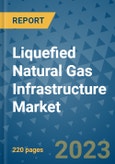The demand for LNG infrastructure is being fueled by a greater focus on smaller-scale facilities and the exponential growth of energy requirements. Key factors influencing the liquefied natural gas infrastructure market include existing exploration and production activities, planned projects, adoption rates, price volatility of crude oil and natural gas, refinery outputs, and offshore/onshore assets. Smaller LNG facilities offer higher profitability due to lower capital expenditure and shorter construction periods compared to larger terminals. The market has witnessed significant investments in small-scale LNG terminals, with export terminals being developed near distribution centers and gas fields, while import terminals cater to the specific natural gas needs of end users.
However, the liquefied natural gas infrastructure market faces restraints such as high capital and operating costs associated with large-scale LNG terminals. The decline in natural gas and crude oil prices has also resulted in lower investments in oil and gas initiatives. Additionally, the COVID-19 pandemic and the US-China trade wars have caused disruptions in global demand-supply dynamics, leading to a supply glut in LNG and restricting additional investments in the liquefied natural gas infrastructure market.
The booming economic growth in the Asia-Pacific (APAC) region directly benefits the LNG infrastructure market, with APAC surpassing Europe as the top export destination for LNG in 2020, experiencing a 67% increase compared to the previous year. China and India are leading the charge in the region's enviable growth rates. Australia is currently planning five LNG import terminals, with one in the site preparation phase, to address the demand-supply mismatch on the country's east coast. Meanwhile, North America boasts large-scale LNG terminals, driven by supply, with the United States operating 110 active LNG terminals. The US shale boom has transformed the natural gas market, positioning the country as the fourth largest exporter of natural gas globally, following Qatar, Australia, and Russia.
The major companies profiled in the report on the liquefied natural gas infrastructure market include BHP Billiton, Exxon Mobil Corporation, Linde AG, Total SA, Chevron Corporation, Royal Dutch Shell, bp p.l.c., ROSNEFT, Petroliam Nasional Berhad (PETRONAS), ConocoPhillips Company, and Santos Ltd. These companies play a significant role in shaping the market through their expertise and contributions to the LNG infrastructure sector.
The global liquefied natural gas infrastructure market is poised for growth, driven by the increasing energy demands of emerging economies and the thriving small-scale LNG facilities. The market offers lucrative opportunities for industry participants, investors, and professionals seeking to capitalize on the expanding LNG infrastructure market.








